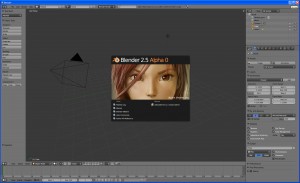Archive for Blender stuff
The new Blender – first look
Posted by: | CommentsI opened the test release for the new Blender 2.5 and it really looks impressive! The design of the interface is new and nice, looks a bit like the rounded theme in the actual version only is much more polished and should be more appealing to new users. I already noticed some of the interface details intended to make it more user friendly than former versions, but even so the classic Blender feel is still there and old users should get around ok as the interface system is still the same. Good work! They will probably allow users who prefer it to choose the old Blender look. Actually I am not sure Blender will be so different and more “easy to learn” with the new face but the more proffesional design will certainly be an incentive for those wondering if it’s worth the effort. Especially architects who are extremely sensitive to design issues 🙂 Read More→
The new Blender
Posted by: | CommentsStop the presses!
The new Blender version was released yesterday as Blender 2.5 Alpha 0 for the community to test. The final stable release will be ready next year so until then I’ll still be learning and using and blogging about Blender 2.49 but I am downloading the test version now just to have a glimpse into the future!
Here is the detailed information
Later post after testing here.
Why Blender?
Posted by: | CommentsMy friend Diana said I am jumping too soon to the “nuts and bolts” before properly introducing Blender to those who never heard of it before. I was amazed such people existed but now that I am aware of that I will try to make the proper introduction and explain what made me invest time in it and why do I think it is a good tool for building architectural visualisations, also what I think the drawbacks are.
Blender is an open source project, it is free and can be used for personal and commercial purposes. There are ways to financially support the people and work behind it, by donating or buying DVDs and books – there are several useful titles on the Blender site. So the price is good, but as I had to replace Max I was looking not only at affordability but also at getting a really good replacement! So I looked around for commercial affordable alternatives and tried some demos but in spite of great promise these applications lacked the complexity I was used to. I really think Blender manages to do a lot more than many commercial software and can compete even the big expensive names. …If you get past the original interface! But I wouldn’t suggest changing it (and any Blender fan would be outraged by such a suggestion) as it is a very good flexible interface. Once I got used to it I felt very at ease navigating the 3d space, I liked the object selection and manipulation methods, found a good set of precision tools. I also tested with some large scenes and it handles complex projects very well. At first I imported in 3ds format models made in cad software and the results were good but then I decided to model in Blender directly and it also went really well. Read More→
Reading the news – Blender and V-ray
Posted by: | CommentsGood morning! Today I don’t have time for an elaborate post but as my girl is toddling happily around the living room and I am drinking my coffee I am reading the news on Blendernation and this morning there is an article about a very good script for integrating V-ray into Blender. V-ray! This is indeed good news for architects using Blender, especially for those rendering interior design images. It seems you only have to buy a 245€ V-ray plugin so that makes it a very good deal indeed. I will post about lighting in Blender soon but just couldn’t wait to get this bit of information in here. I am downloading the trial V-ray to test it.
Blender 2.49 start-up: the interface
Posted by: | CommentsI’m trying to make this as concise as possible. You can also consult the official user manual for other details.
Blender has a really flexible and simple interface. You can have your screen divided any way you like, in adjacent, adjustable windows that you arrange as you wish. Think about the way other software are usually set up: you have the work area with a menu at the top, some floating toolboxes, dockable buttons, rulers, the 3d viewports, in a predefined scheme you can alter to some degree. In Blender you don’t have this sort of differentiations – the screen is divided into any number of identical windows and every one of them can play any part. A Blender window has a header that can be placed at the top or at the bottom. To the left of the header you have a drop down list with all the roles a window can play. As Blender has many functions and modules (meaning it can do a lot of stuff) you have 16 different window types. When you select a different type of window (for 3d view, animation, image editing, etc) the appearance of the window changes and you get other menus or buttons on the header, some window types have floating toolboxes, buttons you can zoom and pan etc. Read More→


